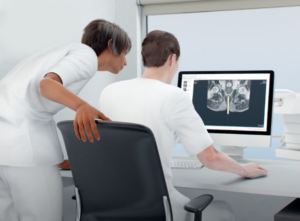Systematic Transrectal Ultrasound (TRUS) Biopsy
TRUS biopsy is one of the commonly used methods. It involves systematically obtaining 10-16 tissue samples from different areas of the prostate. While it has been used for many years, TRUS biopsy has limitations, particularly in detecting small tumors, especially in the anterior and lateral part of the prostate. Resulting in a low negative predictive value and generally under staging of the true aggressiveness of the cancer.
MRI’s Evolution in Prostate Imaging
Since 2004, there has been substantial progress in the development of Magnetic Resonance Imaging (MRI) for prostate examination. Over time, MRI has become a necessary tool to precisely detect and localize the likelihood of benign or malignant cancer within the prostate.
The PI-RADS Scoring System
The high sensitivity of functional multiparametric prostate MRI has led to the implementation of the PI-RADS scoring system. Radiologists use this system to assign scores from 1 to 5 to suspicious lesions within the prostate, as seen in MRI images, to assess the likelihood of prostate cancer.
Tissue Samples for Accurate Diagnosis
While prostate MRI is highly sensitive, it may lack specificity, making it necessary to collect tissue samples for a precise diagnosis regarding the presence and aggressiveness of prostate cancer.
Enhancing Accuracy with MR Targeted Biopsies
The combination of MRI imaging (high sensitivity) with targeted biopsies of lesions with a PI-RADS score of 3, 4, or 5 (high specificity) is considered the most effective approach to accurately detect and diagnose prostate cancer. This underscores the importance of MRI-targeted prostate biopsies.
The European Association of Urology (EAU) now recommends an MRI scan followed by targeted biopsies, with or without additional systematic biopsies, depending on the patient’s clinical background and the biopsy techniques available in your medical facility. For more detailed information on prostate cancer and various biopsy techniques, consult the following pages.
Comparison of Biopsy Methods
 * Luitenaar A, Ex. Review Anti Ther 2019; Jager A, Br J Radiol. 2022 Mar 1; Vilanova JC, Eur J Radiol. 2023 Mar; Tops SCM, J Urol. 2022 Jul; Sandahl M, Eur Urol Open Sci. 2022 May 28; Israel B., BJU int 2021; Vilanova JC, Abdom Radiol (NY). 2020 Dec; Pizzoli SFM, Ecancermedicalscience. 2020 Oct 20; Reijnen JS, Abdom Radiol (NY). 2021 Dec; Wegelin O, Eur Uro Onc. 2019; Subramanian N, J Comput Assist Tomogr. 2021
* Luitenaar A, Ex. Review Anti Ther 2019; Jager A, Br J Radiol. 2022 Mar 1; Vilanova JC, Eur J Radiol. 2023 Mar; Tops SCM, J Urol. 2022 Jul; Sandahl M, Eur Urol Open Sci. 2022 May 28; Israel B., BJU int 2021; Vilanova JC, Abdom Radiol (NY). 2020 Dec; Pizzoli SFM, Ecancermedicalscience. 2020 Oct 20; Reijnen JS, Abdom Radiol (NY). 2021 Dec; Wegelin O, Eur Uro Onc. 2019; Subramanian N, J Comput Assist Tomogr. 2021
** Due to inserting transrectal ultrasound probe
In the landscape of prostate biopsy techniques, four distinct methods have been compared: TRUS, cognitive MR-US fusion, software supported MR-US fusion, and in-bore MR-guided biopsy. TRUS, while cost-effective and requiring minimal user experience, lacks precision in targeting cancer suspicious lesions, has a low negative predictive value and high complication rate due to high number of cores taken. Cognitive MR-US fusion offers a more advanced approach with enhanced MR targeting capabilities but demands significant user experience, suffers from inaccuracies due to prostate deformation, and does not provide detailed documentation of biopsy locations. Software supported MR-US fusion, although requiring high user experience, provides better targeting precision than TRUS but lacks real time MR image confirmation and hereby underestimates the true aggressiveness of smaller lesions. In contrast, in-bore MR-guided biopsies stand out as the most precise and efficient technique. It allows for accurate targeting of small lesions, provide clear visibility of the lesion and most aggressive parts, eliminate inaccuracies related to prostate deformation, and require only 2-3 biopsy cores.
In-bore MR-guided biopsies provide unparalleled precision, making it ideal for patients requiring the utmost accuracy.

 *
* 